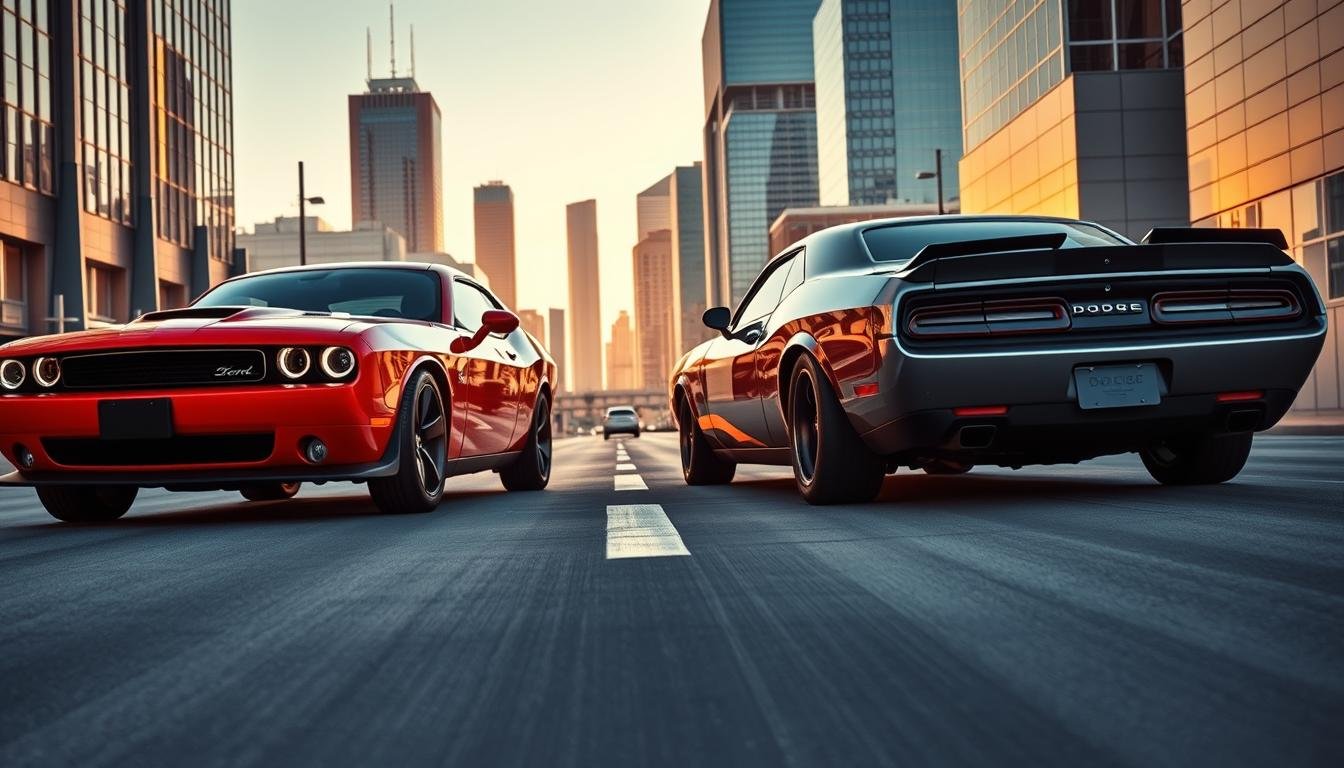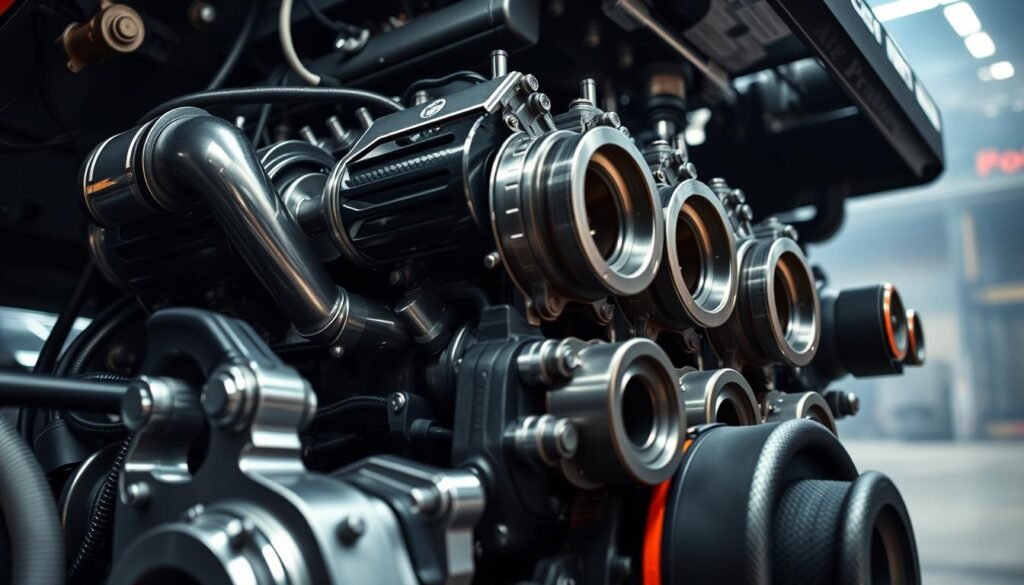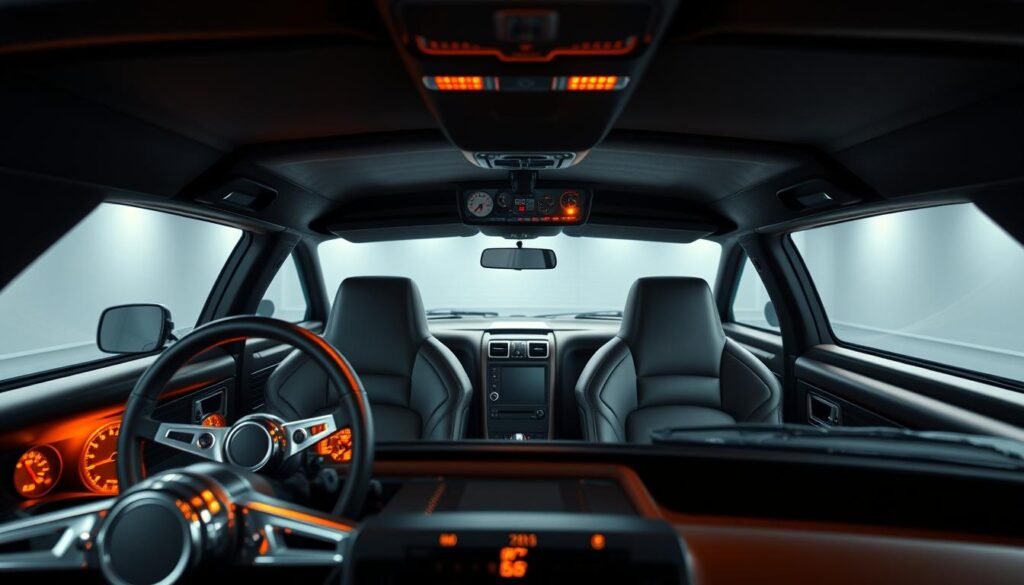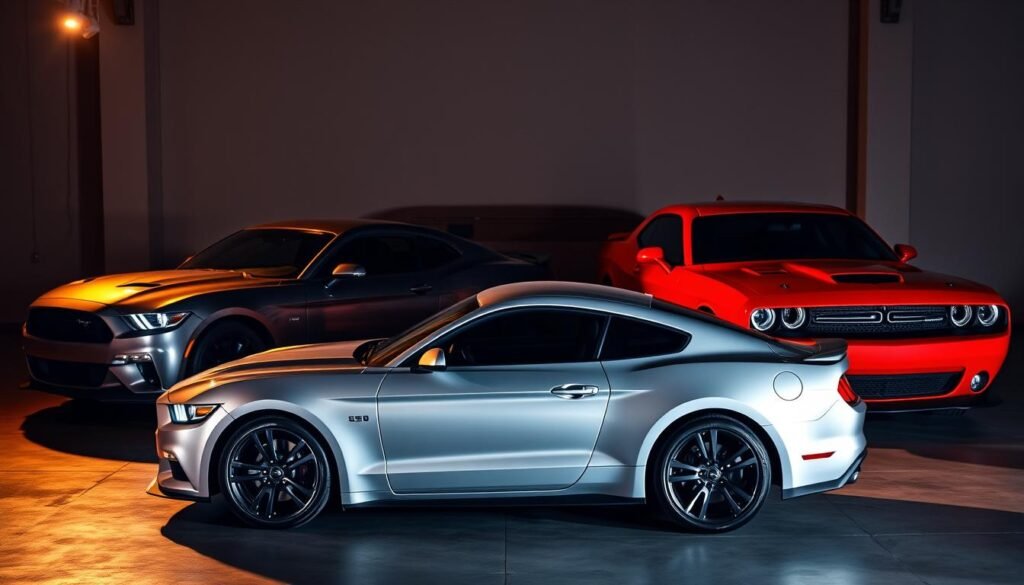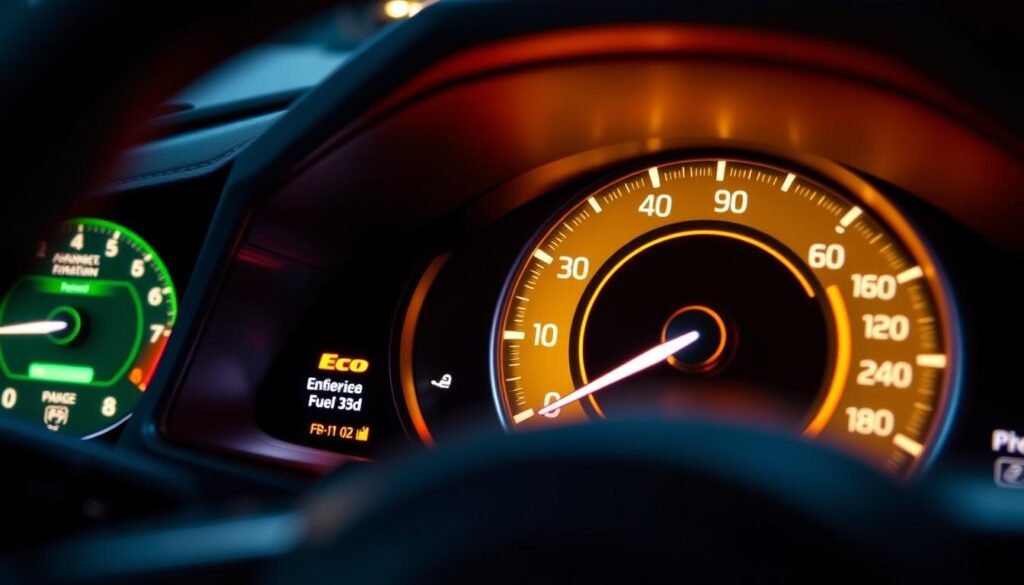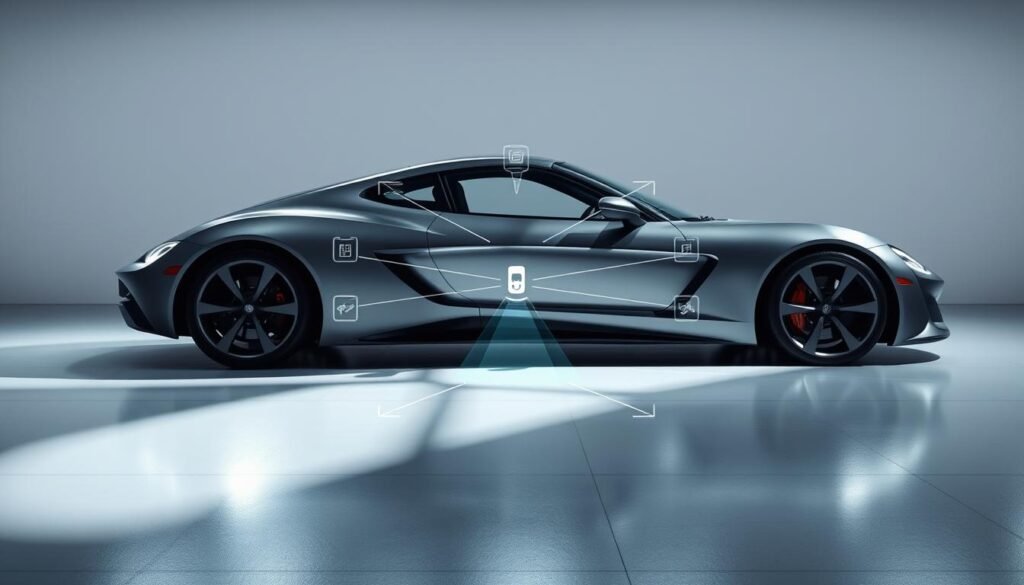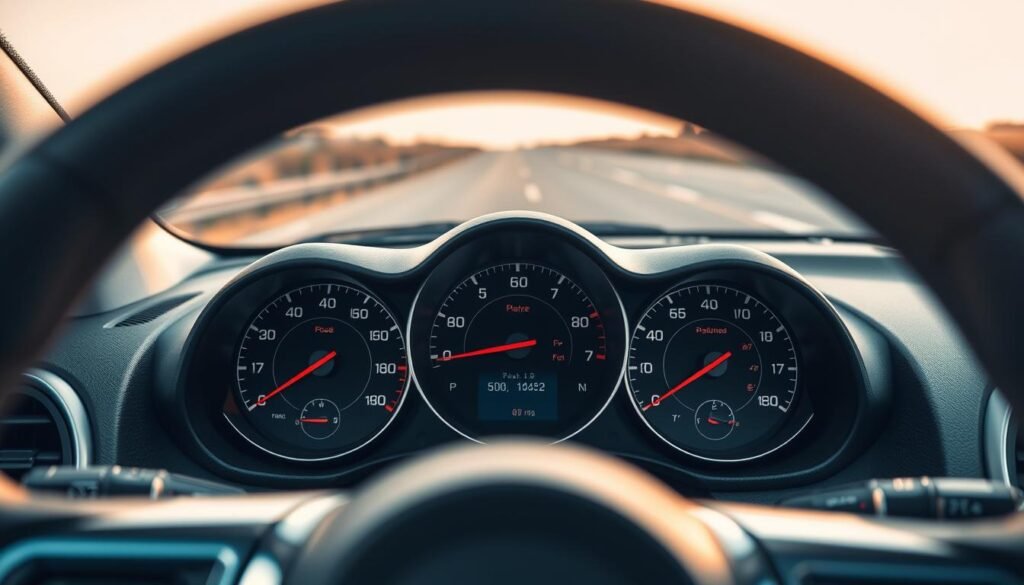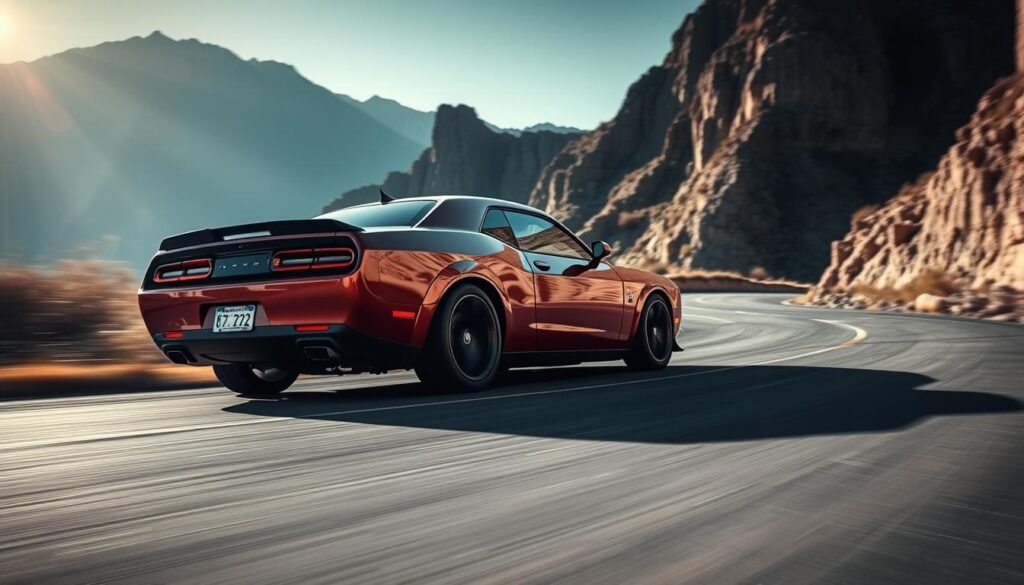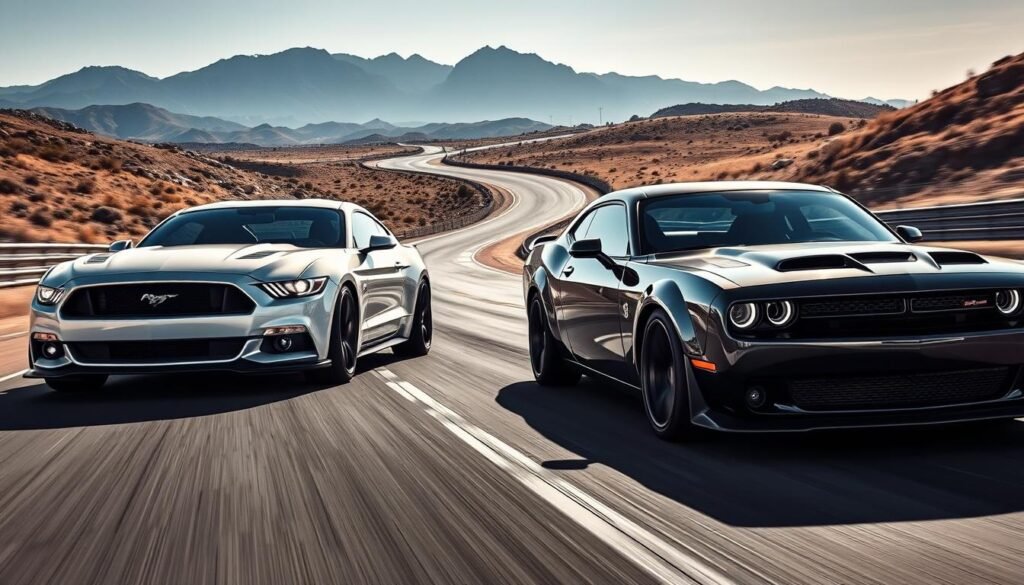The Mustang vs Challenger rivalry highlights America’s love for muscle cars. Both the Ford Mustang and Dodge Challenger hold special spots in car history. They’re known for their powerful engines and standout designs.
This article will compare them in detail. We’ll look at their engine strength, how they handle on the road, what’s inside, their cost, and more. This will help you choose which car suits you best.
Introduction to the Muscle Car Rivalry
For decades, the Ford Mustang and Dodge Challenger have fueled a fierce rivalry. This competition began in the 1960s. That’s when these cars first appeared, each bringing its own special style.
The Mustang was introduced in 1964, quickly becoming a symbol of American car culture. It was the first “pony car,” which was affordable yet fast. This made fast cars available to more people. Dodge launched the Challenger in 1970. It featured bold looks and powerful performance.
The battle between the Mustang and Challenger has evolved over the years. Each version has kept up with new technology and changing tastes. Yet, they’ve both kept the charm that made them famous. Their ongoing rivalry showcases their lasting appeal and importance in performance cars.
The Mustang and Challenger mean more than just their specs and speed. They stand for freedom, power, and constant improvement in cars. By knowing their history, we gain a deeper understanding of their roles and what makes them special.
Performance
When comparing the Mustang and the Challenger, we see where each car shines. The Challenger stands out with engine options ranging from 303 to 797 horsepower, thanks to its supercharged HEMI V-8 Hellcat. The Mustang, on the other hand, starts at 310 horsepower with its turbocharged four-cylinder and peaks at 760 horsepower with the Shelby GT500.
Both cars offer a range that meets various needs, from daily use to high-speed adventures.
Engine Options and Horsepower
Both the Challenger and the Mustang present a wide selection of engines. The Challenger starts at 303 horsepower with a V6 and goes up to a powerful Hellcat engine. Meanwhile, the Mustang offers a bit more at the start with 310 horsepower from a 2.3-liter engine and reaches up to 760 horsepower in the Shelby GT500. This makes both choices thrilling for those who love power.
Acceleration and Top Speed
For muscle car lovers, acceleration and top speed are key. The Challenger’s top engines provide fast acceleration and high top speeds. The Mustang, especially the Shelby GT500, is also a contender with remarkable acceleration and top speeds. These attributes vary with engine choice and car setup.
Handling and Drivetrain
The driving experience is influenced by handling and drivetrain. The Mustang is known for its agile handling, enjoyable on any road. The Challenger, although heavier, offers all-wheel drive, not available in the Mustang. This feature improves its handling in various conditions, adding more control.
Choosing between the Mustang and Challenger comes down to what you value more: power, handling, speed, or drivetrain options.
Price Comparison
Comparing *Mustang* and *Challenger* prices is key for buyers wanting affordable muscle cars. This comparison is essential. It looks at both low and high-end models. This gives a clear picture of what each car offers.
Base Models
The Ford Mustang starts at a lower price than the Dodge Challenger at the base level. This makes the Mustang a good choice for those who want a muscle car that is both affordable and powerful.
| Model | Price |
|---|---|
| Ford Mustang | $27,155 |
| Dodge Challenger | $30,895 |
High-End Models
The pricier Mustang Shelby GT500 and Challenger Hellcat Redeye show a big price difference. The Shelby GT500 has high-end features and better performance, which is why it costs more. Meanwhile, the Challenger Hellcat Redeye provides lots of power and brand value for its price.
| Model | Price |
|---|---|
| Mustang Shelby GT500 | $74,095 |
| Challenger Hellcat Redeye | $82,345 |
Mustang vs Challenger: Interior Features
The Mustang and Challenger offer a mix of muscle car comfort and high-tech features for an exciting drive. The Mustang stands out with its sporty interior, featuring seats that hug your body and a layout focused on the driver. It combines a sporty look with comfort, offering heated and ventilated front seats, a warm steering wheel, and automatic climate control for two zones.
The Challenger, on the other hand, is more about space, perfect for those who want comfort and room to stretch. It boasts a bigger trunk and more space in the back, making long drives more comfortable. It also features an eight-way power seat for the driver and a larger touch-screen than the Mustang, upping its comfort and tech game.
The Mustang is equipped with the Ford SYNC 3 system, which includes an 8-inch touchscreen and apps like Apple CarPlay and Android Auto. It also has an optional 12-inch digital display for drivers. The Challenger isn’t far behind with its Uconnect system, an 8.4-inch touchscreen, and handy features for the road, including navigation and voice commands.
| Mustang | Challenger | |
|---|---|---|
| Seating Comfort | Heated and ventilated front seats, driver-focus | Spacious, eight-way power driver’s seat |
| Infotainment | Ford SYNC 3 with 8-inch touchscreen | Uconnect with 8.4-inch touchscreen |
| Tech Features | Apple CarPlay, Android Auto, 12-inch digital cluster | Navigation, voice command controls |
Choosing between the Mustang and Challenger depends on what matters more to you in a car. The Mustang is all about a sporty vibe and tech-smarts. The Challenger, however, gives you more room and a strong tech package for ultimate comfort.
Exterior Styling and Customization
The Ford Mustang and Dodge Challenger mix old-school muscle car looks with modern style. Both cars keep their iconic, tough looks while adding new touches. This combo highlights their rich history and today’s trends.
Design Philosophy
The Ford Mustang brings feelings of tradition and speed. With its sleek shape, sharp corners, and famous tri-bar back lights, it stands out on the road. Meanwhile, the Dodge Challenger goes for a classic vibe. It shows off with a broad shape, bold lines, and its well-known split grille. Each car has its own style, attracting different fans of muscle car designs.
Customization Options
Both the Mustang and Challenger let fans make their cars their own. You can pick colors, graphics, and even performance upgrades. There’s a lot to choose from. For example, the Mustang has packages like the GT Performance Package. It makes the car handle better and more aerodynamic. The Challenger offers the Scat Pack and Hellcat packages. They not only improve the car’s power but also let you tweak how it looks.
These customization options mean car lovers can make their vehicles truly theirs. It shows how car makers understand people’s different tastes in muscle cars. Each car can mirror its owner’s style perfectly.
Dimensions and Space
The Ford Mustang and Dodge Challenger have different car sizes that might change what you pick. The Mustang is sleek and easy to drive in cities. The Challenger is bigger and gives you more room inside.
The Challenger shines when you look inside. It has lots of room for your legs and stuff, making it great for long trips or carrying things. The Mustang, however, might be a bit tight for people sitting in the back.
| Specification | Ford Mustang | Dodge Challenger |
|---|---|---|
| Length | 188.3 inches | 197.9 inches |
| Width | 75.4 inches | 85.4 inches |
| Height | 54.3 inches | 57.2 inches |
| Rear Legroom | 29 inches | 33.1 inches |
| Cargo Space | 13.5 cubic feet | 16.2 cubic feet |
Fuel Economy
Fuel efficiency is key for high-performance cars like Mustang and Challenger. They have different engines affecting their Mustang vs Challenger MPG ratings.
The Mustang with its EcoBoost engine shines in fuel efficiency. This makes it a more eco-friendly car in its class. The Charger, however, strikes a good balance with its V6 and V8 engines, mixing power and efficiency.
| Model | Engine | City MPG | Highway MPG |
|---|---|---|---|
| Ford Mustang EcoBoost | 2.3L Turbo I4 | 21 | 32 |
| Dodge Challenger SXT | 3.6L V6 | 19 | 30 |
| Ford Mustang GT | 5.0L V8 | 15 | 24 |
| Dodge Challenger R/T | 5.7L V8 | 16 | 25 |
V8 engines use more gas but offer thrilling performance. But, the base models with smaller engines provide a great mix of efficiency and power.
Safety Features
Even in fast cars, safety is key. It’s important to pick a muscle car that has the right safety tools. This mix of speed and safety is thanks to new car safety tech.
Standard Safety Equipment
The Mustang and Challenger come with many safety features. These include:
- Anti-lock Braking System (ABS)
- Traction Control
- Electronic Stability Control (ESC)
- Advanced Airbag System
- Rearview Camera
These features use the latest safety tech to make every trip safe. Things like traction control keep the car stable, even when the driving gets tough. The advanced airbags are super important for protecting you if there’s a crash.
Optional Safety Upgrades
Want more safety? You can add extra features. These upgrades include:
- Adaptive Cruise Control
- Blind-Spot Monitoring
- Lane-Keeping Assist
- Forward Collision Warning
- Automatic Emergency Braking
Adaptive cruise control and blind-spot monitoring help a lot on highways. Forward collision warning and automatic braking help avoid crashes. With these extra features, the Mustang and Challenger become even safer without losing their fun to drive.
Reliability
When looking into car reliability, the Mustang and Challenger shine in different ways. Both are top examples of dependable muscle cars. However, they do not match up exactly in reliability and maintenance ease.
J.D. Power’s data shows both cars have good reliability scores. But, when we look closer, we see differences. The cost of repairs and maintenance plays a big part in your car experience. Here’s a side-by-side comparison:
| Aspect | Mustang | Challenger |
|---|---|---|
| Average Annual Repair Cost | $703 | $650 |
| Frequency of Unscheduled Repairs | 0.4 times per year | 0.5 times per year |
| Manufacturer Warranty | 3 years/36,000 miles | 3 years/36,000 miles |
The Mustang might cost a bit more in yearly repairs than the Challenger. But the Challenger goes to the shop more often without planning. When thinking about vehicle maintenance and car reliability for the long term, these details matter.
Both Ford and Dodge give similar warranties. Yet, what these warranties cover can vary, so knowing the details is key. To keep these dependable muscle cars running well, follow the maintenance schedule in the owner’s manual closely.
Driving Experience
When talking about driving, the Mustang and Challenger cater to muscle car fans in their own ways. Driving dynamics are key to their unique feel.
The Mustang shines with responsive control. It has a precision-tuned suspension and precise steering. These make it super agile, great for sharp turns and quick moves. This lets drivers enjoy city rides and track days to the fullest.
The Challenger, however, offers a powerful, thrilling ride with a strong engine and a heavier feel. Its suspension smooths out bumpy roads. Though not as nimble as the Mustang, it brings solid driving dynamics that fans of classic muscle cars love.
Let’s look closer at what makes the driving experience of these cars stand out:
| Feature | Mustang | Challenger |
|---|---|---|
| Steering Responsiveness | Precise, agile | Heavier, stable |
| Suspension Tuning | Sport-tuned, tight | Smoother, flexible |
| Handling Characteristics | Responsive control, enhanced cornering | Classic muscle car handling, stable performance |
In the end, choosing between these two muscle cars depends on what kind of driving dynamics you prefer. It’s about whether you want the Mustang’s responsive control or the Challenger’s classic appeal.
Which Car is Faster?
People often compare the Mustang and Challenger’s speed by looking at 0-60 mph times and quarter-mile speeds. These measures help us see which muscle car is the fastest.
The Shelby GT500 version of the Ford Mustang is known for its quick acceleration. It can go from 0 to 60 mph in about 3.5 seconds. Its quarter-mile time is around 11 seconds, proving it’s really fast.
The Dodge Challenger has a model called the SRT Hellcat Redeye that’s also super fast. It can reach 0-60 mph in about 3.4 seconds. And it runs the quarter-mile in roughly 10.8 seconds, making it a top contender among the quickest muscle cars.
Here’s a clear comparison of how these two mighty muscle cars stack up:
| Metric | Mustang Shelby GT500 | Dodge Challenger SRT Hellcat Redeye |
|---|---|---|
| 0-60 mph | 3.5 seconds | 3.4 seconds |
| Quarter-Mile Time | 11 seconds | 10.8 seconds |
| Horsepower | 760 hp | 797 hp |
The speed test results show a tight race between the two cars. The slight advantage in speed and quarter-mile times might catch the eye of thrill seekers.
Which Car is More Comfortable?
When comparing car comfort, Mustang and Challenger have their perks. Mustang brings comfort with plush seats and soft interiors for everyone inside. Challenger stands out in space, offering lots of legroom and headroom, making it a top choice for a spacious muscle car.
Mustang rides smoothly, thanks to its advanced suspension that eases bumps. Challenger gives a firm ride but keeps things comfy. Both cars are good at keeping noise out, but Mustang is often the quieter choice for long trips.
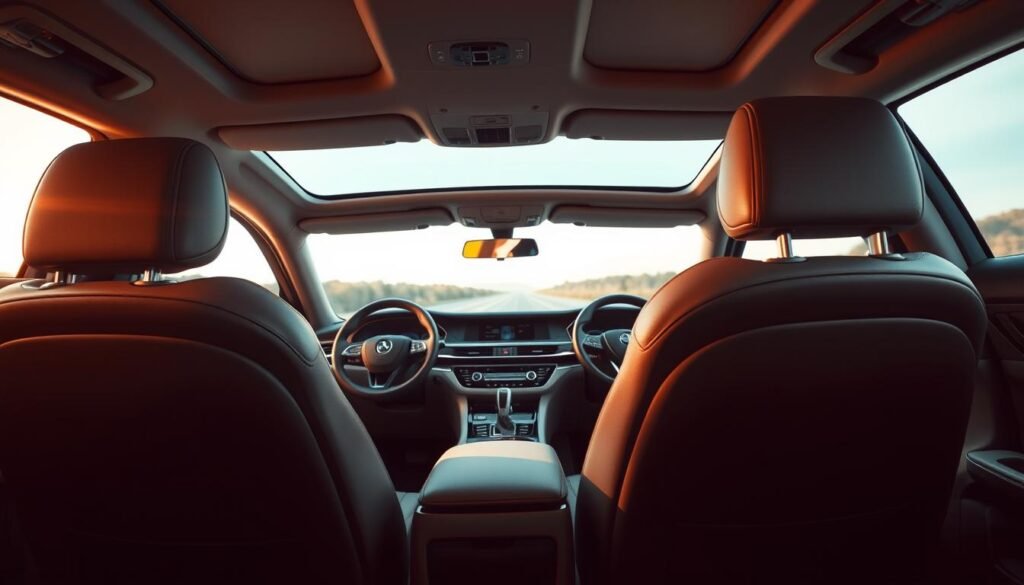
Looking at seat configuration and interior amenities, Mustang’s seats have ergonomic support. They can be heated or cooled for extra comfort. Challenger also offers great seats and is unique because it can fit three people in the back seat comfortably.
In conclusion, Challenger scores with its roominess, and Mustang impresses with quietness and smoothness. They cater to different tastes for a comfortable driving experience.
Conclusion
As we wrap up this detailed car comparison, both the Ford Mustang and the Dodge Challenger shine in their own ways. Choosing the right one depends on what you look for in a car.
For those who love modern tech, sharp handling, and various engine choices, the Mustang is a great pick. It balances power and smooth driving, perfect for fans of agility and innovation.
The Challenger, however, offers a throwback with its classic look, strong power, and roomy inside. It’s ideal for those who love raw strength and a design that echoes vintage muscle cars.
Deciding between the Mustang and Challenger means thinking about performance, cost, what’s inside, and your own tastes. No matter your choice, both cars promise an exciting journey.
FAQ
How do the engine options and horsepower compare between the Mustang and the Challenger?
The Dodge Challenger’s horsepower ranges from 303 with a V6 to 797 with a supercharged V8. The Ford Mustang starts at 310 horsepower with a turbocharged four-cylinder and reaches up to 760 in the GT500.
Which car accelerates faster, the Mustang or the Challenger?
Thanks to its slightly lighter weight and high-tech design, the Mustang’s Shelby GT500 accelerates faster than the Challenger Hellcat.
What are the main differences in handling and drivetrain options between the Mustang and Challenger?
The Mustang is known for its agile handling and sportier feel. On the other hand, the heavier Challenger offers an all-wheel-drive option, which is not available in the Mustang. This gives the Challenger better traction and stability.
How does the pricing of base models between the Mustang and Challenger compare?
The starting price for the Ford Mustang is usually a bit lower than the Dodge Challenger’s. Yet, the total cost can increase significantly with added options and higher-end models.
What can I expect in terms of high-end model pricing?
The Mustang Shelby GT500 and the Challenger Hellcat Redeye have high price tags. They’re priced higher because they offer more power, luxury, and brand value. Expect to pay a lot more for these models compared to the basic ones.
How do the interior features of the Mustang and Challenger compare?
The Challenger boasts a roomier interior and features like a large touchscreen and power driver’s seat. The Mustang, however, offers a driver-focused interior with sporty touches and modern tech.
What are the design philosophies behind the Mustang and Challenger?
The Mustang sports a more modern, aerodynamic look. Meanwhile, the Challenger has a bolder, classic muscle car style. Both cars offer customization options to match personal preferences.
How do the physical dimensions and space compare between the Mustang and Challenger?
The Challenger is noticeably larger, providing more room for cargo and backseat passengers than the Mustang. This might appeal more to those valuing space and comfort.
Which car has better fuel economy, the Mustang or the Challenger?
The Mustang often has a slight edge in fuel efficiency, especially with its smaller engines. However, both cars are designed with performance in mind, which affects their fuel economy.
What safety features do the Mustang and Challenger offer?
Both offer key safety features like airbags and stability control. They also have optional safety upgrades. These include adaptive cruise control and blind-spot monitoring, making both cars safe options.
Are the Mustang and Challenger reliable cars?
Generally, both have strong reliability records. However, it’s good to check specific models through sources like J.D. Power ratings.
What is the driving experience like for the Mustang compared to the Challenger?
The Mustang offers nimble handling and quick steering, making for a sportier ride. The Challenger, with its bulkier frame and powerful engines, feels more stable and strong.
Which car is faster, the Mustang or the Challenger?
The Mustang, especially the GT500 model, usually has faster acceleration and higher speeds than the Challenger, even its Hellcat version.
Which car is more comfortable for daily driving, the Mustang or the Challenger?
For everyday use, the Challenger’s roominess and smooth ride make it more comfortable. The Mustang, while fun, may be less comfy for long drives.

